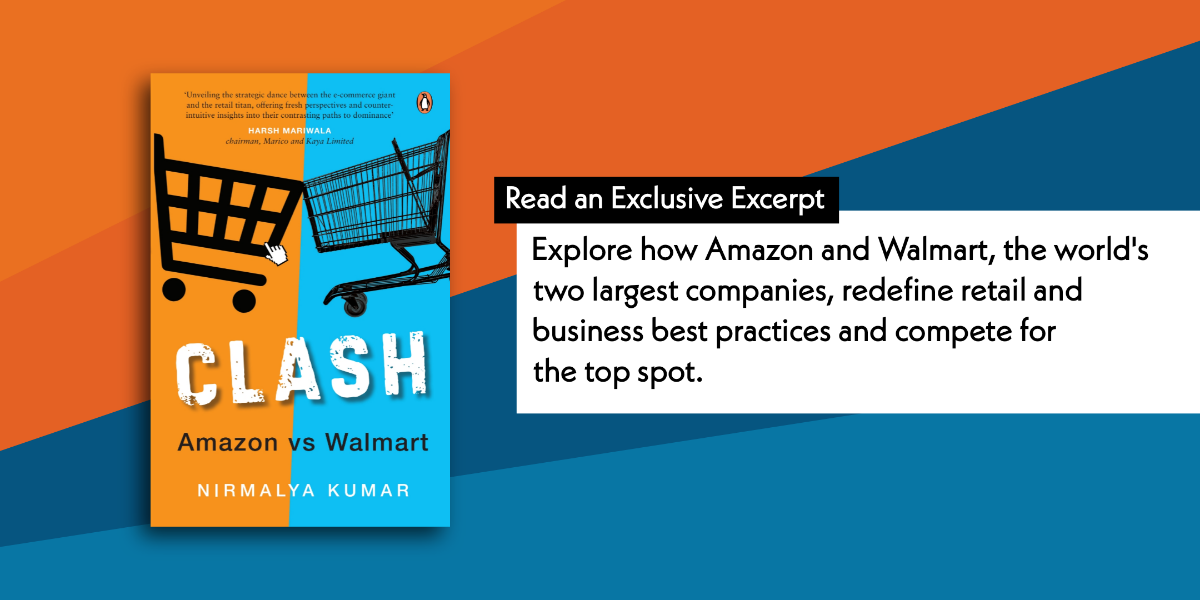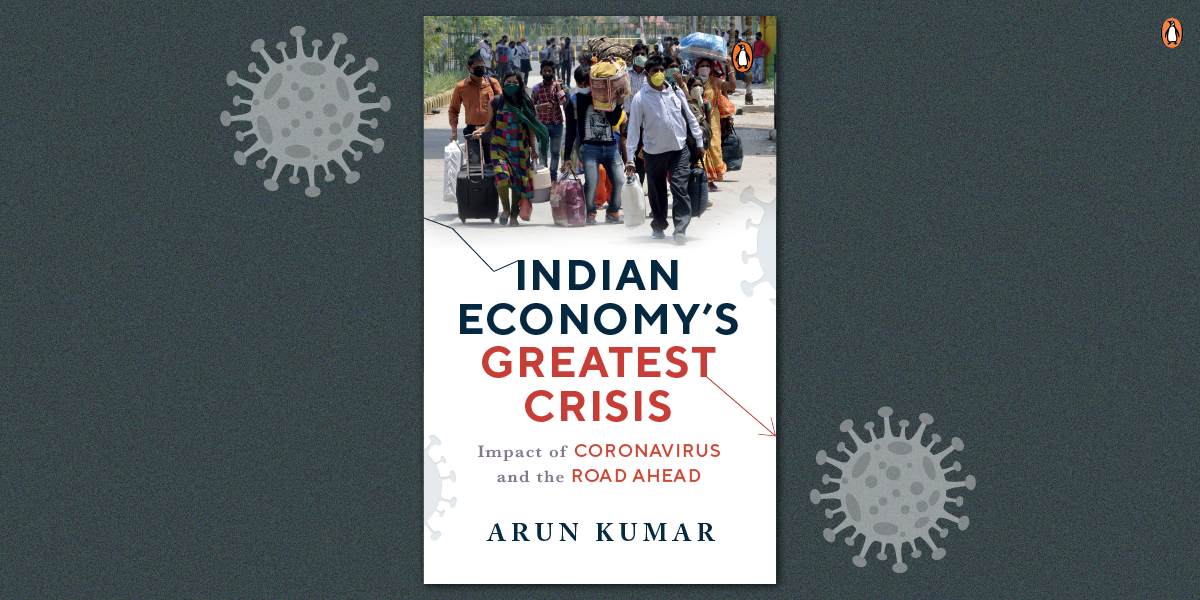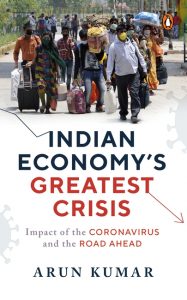Curious about the evolving retail landscape and the roles played by industry giants like Amazon and Walmart? In Nirmalya Kumar‘s Clash, find out how these titans impact the lives of everyday consumers, giving a new meaning to digital convenience and challenging the traditional shopping experience.
Read this excerpt as the world’s two largest companies, redefine retail and business best practices, and fight the ultimate battle for your buck!

***
In the charming suburban town of Harmonyville lived a woman named Elimijn, a dedicated and caring housewife. Her days were filled with taking care of her family, managing the household and pursuing her creative hobbies. Two giants, Amazon and Walmart, played unexpected and integral roles in her life’s journey.
Elimijn was an avid reader and an aspiring artist. She loved exploring different genres of books and finding new sources of inspiration for her art. Amazon became her digital haven, offering an extensive collection of books, art supplies and crafting tools. With a few clicks, Elimijn could order the latest bestseller, a set of watercolour paints or even a specialized easel, all delivered right to her doorstep.
But Elimijn’s affection for retail didn’t end online. Walmart, with its sprawling store just a short drive away, provided a unique sensory experience. Elimijn enjoyed the tactile pleasure of wandering through its aisles, exploring a vast variety of products. She would often visit with a list in hand, making her way through the neatly organized shelves, hand-picking fresh groceries, household essentials and even some affordable fashion finds.
What set Amazon and Walmart apart in Elimijn’s heart was their balance in her life. Amazon’s convenience saved her time and effort, allowing her to spend more precious moments with her family and immerse herself in her hobbies. On the other hand, Walmart’s physical presence gave her a chance to step out, breathe in the air and indulge in a bit of old-fashioned retail therapy.
During holidays, Amazon’s quick shipping helped Elimijn avoid the holiday rush. She could order thoughtful gifts for her loved ones, wrapping them up with care and sharing the joy of giving. But the annual tradition of visiting Walmart to select the perfect Christmas tree with her family remained unchanged. The smell of pine needles, the twinkling lights and the festive atmosphere created cherished memories that couldn’t be replicated online.
Elimijn’s relationship with these retail giants wasn’t just about transactions. It was about the roles they played in her life’s narrative. Amazon’s efficiency became a trusted ally in her daily routine, while Walmart’s physical presence provided a sense of connection to her community. In a surprising twist, Elimijn’s creative endeavours gained recognition online. Her artwork found a following on social media, and soon enough, she was approached by both Amazon and Walmart to collaborate on exclusive lines of products. Amazon showcased her art supplies and books, while Walmart featured her artwork on select merchandise. Elimijn found herself at the crossroads of the very stores she had come to love. Her story was a reminder that these giants weren’t just about commerce—they were about opportunities, experiences and connections. Through Elimijn’s journey, Amazon and Walmart became not just retailers, but integral parts of her life, shaping her routines, her passions and even her dreams.
The battle between Amazon and Walmart, or more generally between online retail and physical stores, is often presented as a zero-sum game. It is believed that as online retailing becomes more popular, consumers will increasingly abandon brick-and mortar stores. Clearly, there is some evidence supporting this as many traditional retail chains have gone bankrupt while online retailers like Amazon and Alibaba continue to deliver dramatic growth numbers. This difference in growth is also reflected, as noted earlier, in the hefty valuation that the markets place on disruptive e-commerce players relative to incumbent physical retailers.
In this chapter, we will build a more nuanced picture of this competition. Specifically, we will investigate if there are certain types of customers, particular buying situations and some product categories where the relative attractiveness of physical stores like Walmart is superior to online stores like Amazon and vice versa. In exploring this, we will restrict our focus to the US, as it is the country where online retailing began and is most evolved, while also being the largest source of revenue for both Amazon and Walmart. Furthermore, we will use my Marketing as Strategy book’s 3Vs framework of valued customer (who to serve?), value proposition (what to offer?) and value network (how to deliver?) to investigate the differences between these two retail giants. The valued customer and value proposition aspects are discussed in this chapter, while the value network will be the focus of the next two chapters.
Who is the target segment for each retailer? Market segments, as we are taught, should be mutually exclusive and collectively exhaustive. Therefore, instinctively, marketers seek to answer this question by demonstrating that the types of people, based on demographic variables such as age, sex, education, income and geographical location, who prefer Amazon are different from those who patronize Walmart for their shopping needs.
However, customers in the real world, as the data will show, do not fall neatly into well-defined boxes. When asked, people often respond that relative to Walmart, Amazon shoppers are younger, more urban and educated, with higher income levels. They also see Amazon shoppers as more technologically savvy, forgetting that ordering on the mobile phone app is not a novelty or challenging any more. While the data does feed this stereotype to some extent, the differences in these demographic variables between Amazon and Walmart shoppers are not that dramatic, and furthermore, are decreasing over time.
Research indicates that the average (mean level) income of Amazon shoppers at $84,449 is only 11 per cent higher than for those who shop at Walmart ($76,313).2 Digging deeper, the typical (modal level) Walmart shopper is a married white woman with an undergraduate degree, between fifty-five and sixty-four years old, living in the suburbs of south-eastern USA, earning about $80,000 annually.3 However, this segment also frequents Amazon because Amazon’s typical shopper is a college-educated married woman, living in the south-east, earning more than $80,000 a year, but split across two age brackets: thirty-five to forty-four and fifty-five to sixty-four. Thus, a segmentation based on demographic variables does not give an accurate picture, as consumers do not shop exclusively at either Amazon or Walmart, which I am sure also reflects the behaviour of any American reader of this book.
***
Get your copy of CLASH: Amazon vs Walmart by Nirmalya Kumar wherever books are sold.

















